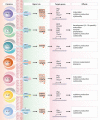JAK/STAT Cytokine Signaling at the Crossroad of NK Cell Development and Maturation
- PMID: 31781102
- PMCID: PMC6861185
- DOI: 10.3389/fimmu.2019.02590
JAK/STAT Cytokine Signaling at the Crossroad of NK Cell Development and Maturation
Abstract
Natural Killer (NK) cells are cytotoxic lymphocytes of the innate immune system and play a critical role in anti-viral and anti-tumor responses. NK cells develop in the bone marrow from hematopoietic stem cells (HSCs) that differentiate through common lymphoid progenitors (CLPs) to NK lineage-restricted progenitors (NKPs). The orchestrated action of multiple cytokines is crucial for NK cell development and maturation. Many of these cytokines such as IL-2, IL-7, IL-12, IL-15, IL-21, IL-27, and interferons (IFNs) signal via the Janus Kinase / Signal Transducer and Activator of Transcription (JAK/STAT) pathway. We here review the current knowledge about these cytokines and the downstream signaling involved in the development and maturation of conventional NK cells and their close relatives, innate lymphoid cells type 1 (ILC1). We further discuss the role of suppressor of cytokine signaling (SOCS) proteins in NK cells and highlight their potential for therapeutic application.
Keywords: ILC1; JAK; NK cell; SOCS; STAT; cytokine; development; maturation.
Copyright © 2019 Gotthardt, Trifinopoulos, Sexl and Putz.
Figures



References
Publication types
MeSH terms
Substances
Grants and funding
LinkOut - more resources
Full Text Sources
Other Literature Sources
Miscellaneous

